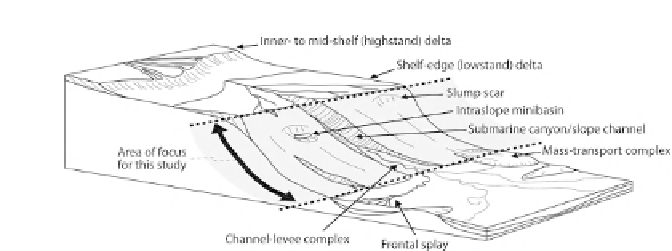Environmental Engineering Reference
In-Depth Information
FIGURE 1
Schematic overview of a continental margin highlighting the various subenvironments.
Modified from
Posamentier and Walker (2006
).
reasons, there has been a relative paucity of ichnological studies focused on the
deposits of slope environments.
The integration of ichnological and sedimentological data is necessary in
order to construct robust depositional models for ancient sedimentary succes-
sions. Over the past two decades, substantial sedimentological and geomorpho-
logical analyses of slope units have led to a superior understanding of these
settings, including the dominant physical processes (e.g.,
Hodgson et al.,
2011; Normark et al., 2009; Paull et al., 2005; Posamentier and Kolla, 2003;
Prather et al., 1998
). These studies provide the framework for integrating
trace-fossil data, which will lead, ultimately, to the development of more robust
facies models suited for interpretations of slope stratigraphy. In his classical
work,
Seilacher (1967)
considered the
Zoophycos
Ichnofacies to be character-
istic of the zone between the area of wave-influence (i.e., the shelf) and turbidite
sedimentation (i.e., the basin-floor). Of course, we now better appreciate
the breadth of sedimentary processes that impact the slope, including both depo-
sitional and bypassing turbidity currents. In popular bathymetric schemes,
the
Zoophycos
Ichnofacies is typically portrayed as an intermediary between
the
Cruziana
Ichnofacies and the
Nereites
Ichnofacies (cf.
MacEachern
et al., 2007a
), a perception that does the ichnofacies a disservice. Reevaluation
of the
Zoophycos
Ichnofacies by
Seilacher (1978)
and
Frey and Seilacher (1980)
showed that one of the major environmental controls typifying the
Zoophycos
Ichnofacies is lowered oxygen levels, associated with organic debris accumu-
lating in largely persistent low-energy regimes. Such conditions are commonly
characteristic of distal (outer) shelf settings as well as slope settings that lack
persistent oceanic currents. In more dynamic slope environments, however,
the resulting ichnological suites are more diverse, but commonly remain within
the ethological constraints of the
Zoophycos
Ichnofacies.
It is now widely recognized that gravity flows, including turbidity currents,
shape the bathyal realm (cf.
Posamentier and Walker, 2006
). Recent studies
have revealed a marked variability in the character of bathyal depositional sub-
environments (
Fig. 1
). The focus of this review includes submarine canyons,
intraslope minibasins, slope channels, and levee complexes.






Search WWH ::

Custom Search